Understand lithium battery anode material-spherical graphite
Graphite (referring to natural stone, the same below) is a non-metallic mineral resource. Graphite materials have various special properties such as high temperature resistance, electrical conductivity, thermal conductivity, lubrication, chemical stability, plasticity, and thermal shock resistance. Among them, spherical graphite is a high-end product in graphite and is used in strategic emerging industries such as new energy vehicles, energy storage, and environmental protection.
Spherical graphite is made of high-quality high-carbon natural flake graphite as raw material, and the graphite surface is modified by advanced processing technology to produce graphite products with different fineness and shape like oval spheres.
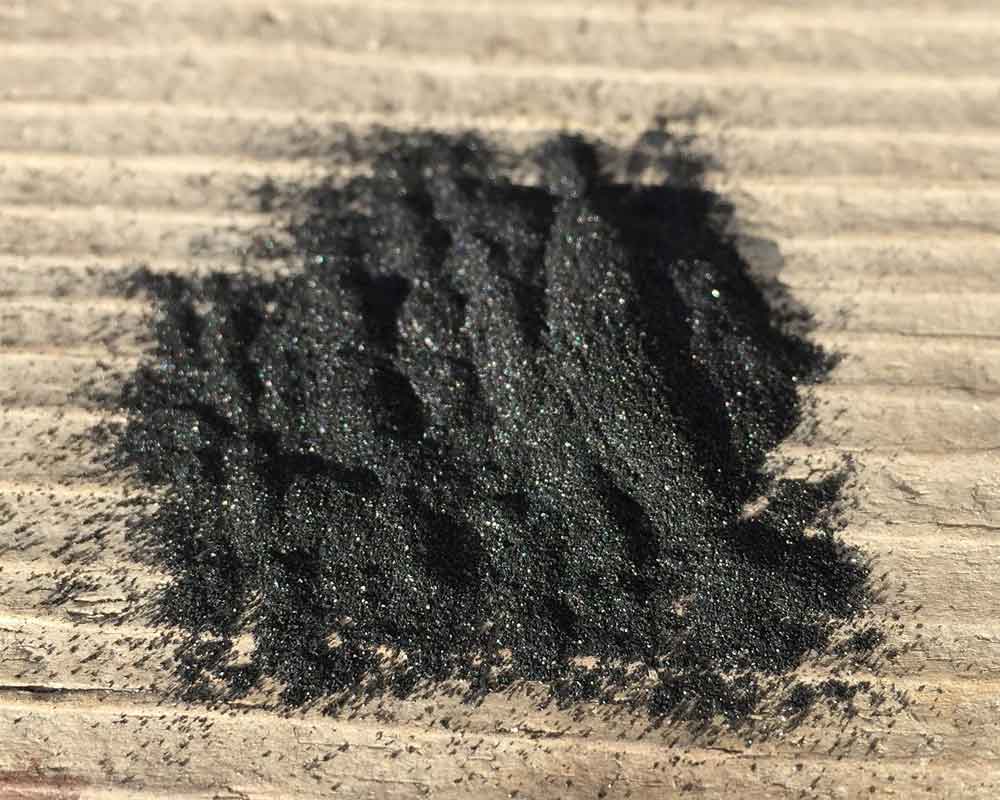
Indicators for measuring spherical graphite
- Physical performance index
Particle size (D50, μm), tap density (g/cm³), specific surface area (㎡/g), moisture (%), fixed carbon (%)
- Electrochemical performance index
Coulomb efficiency (%), charging capacity (mAh/g), cycle life (cycles)
Advantages and disadvantages of natural graphite
Natural graphite has the advantages of being used as a negative electrode material for lithium-ion batteries: wide sources, low price, low charge and discharge voltage platform, and high reversible capacity (theoretical value 372mAh/g).
However, there are many problems with graphite as the negative electrode material of the battery: poor compatibility with solvents; poor performance in high-current charging and discharging; during the first charge and discharge, the graphite layer is peeled off due to the co-embedding of solvent molecules, which leads to a reduction in electrode life.
Formation of spherical graphite
Through the spheroidization of flake graphite, the specific capacity (≥350mAh/g), the first cycle efficiency (≥85%) and cycle performance of the negative electrode material can be significantly improved.
- The size of the granularity
As a negative electrode material for lithium-ion batteries, the particle size D50 is most suitable between 16 and 18 μm. If the particle size is too small, the specific surface area will be larger, causing the negative electrode to consume a large amount of Li+ during the first cycle, thus forming a solid dielectric interfacial film, which is the first charge and discharge efficiency; The liquid contact area is small, which affects the specific capacity of the negative electrode.
- Spherical graphite production equipment
The production of spherical graphite has been industrialized. In industrial production, wind impact shaping machines are mainly used to spheroidize flake graphite. Among them, the airflow vortex pulverizer is a commonly used equipment. This method has less impurities during the spheroidization process, but its equipment is large in size, and the amount of graphite is large, and the yield is low, which is very limited in laboratory preparation.
Modification of spherical graphite
There are two main starting points for the modification:
1. Appropriately reduce the specific surface area of the stone mill to reduce the irreversible loss caused by the excessive stroke of the SEI film and the co-embedding of solvent molecules that cause the laminar peeling of graphite;
2. Introduce other metal elements or non-metals into graphite to increase the charge and discharge capacity of graphite.
- Coating method-improve the cycle performance of graphite
The "core-shell" model coating method uses graphite materials as the "core", and a "shell" of an amorphous carbon material is coated on its surface. The precursors of the commonly used amorphous carbon materials include phenolic resin, Epoxy resin and cracked carbon. The layer spacing of amorphous carbon materials is larger than that of graphite, which can improve the diffusion performance of lithium ions in it, which is equivalent to forming a buffer layer of lithium ions on the outer surface of graphite, thereby improving the high-current charge and discharge performance of graphite materials.
The coating method improves the cycle life of the battery, but the current coating process still has certain problems. The key problem to be solved at present is how to form a complete, uniform coating layer outside the graphite and well combined with the graphite.
- Doping method-increase the charge and discharge capacity of graphite
The introduction of certain metallic or non-metallic elements into carbon materials will result in changes in the carbon microstructure and electronic state, which will affect the lithium insertion behavior of carbon electrodes. At present, the most researched is the introduction of boron, silicon, and phosphorus into carbon materials. And other elements.
Other commonly used modification methods: surface oxidation, metal layer formation, mechanical grinding
Spherical graphite material has good electrical conductivity, high crystallinity, low cost, high theoretical lithium insertion capacity, low charge and discharge potential and flatness. It is an important part of lithium-ion battery anode material and is a cathode material for lithium-ion battery production at home and abroad. The replacement product. It has excellent electrical conductivity and chemical stability, high charge and discharge capacity, long cycle life, and environmental protection.
Factors affecting the processing fineness of jet mill
The main factors that affect the pulverization fineness of the jet mill are: material properties, processing capacity, gas pressure, feed particle size, raw material particle size distribution, whether it is a mixture, and so on.
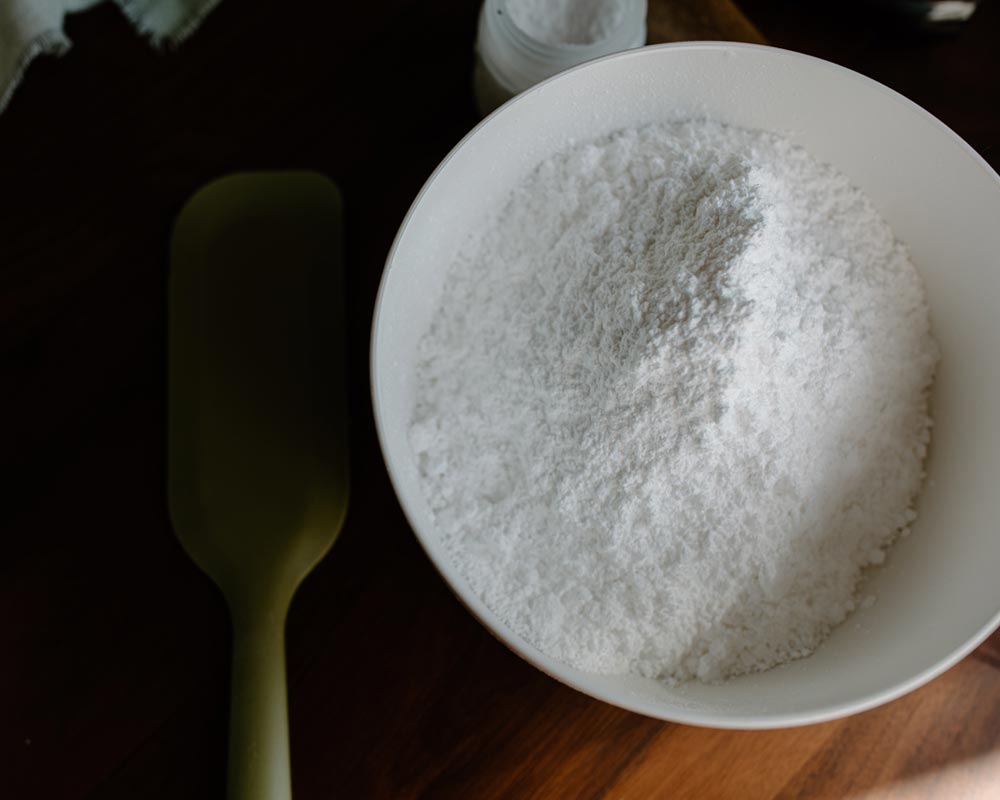
Material properties: Generally speaking, the jet mill can be adapted to the crushing of all brittle materials. However, due to the different nature of the material, its crushing performance is also different. Due to the difference in the strength, density, hardness, viscosity, shape and electrical properties of various materials, it will inevitably lead to differences in the crushing results, and the strength of the material is an important influencing factor. In addition, due to the excessive moisture content of certain materials or the water or oil in the gas source, the properties of the crushed materials such as the increase in toughness and viscosity will affect the fineness of crushing.
Processing capacity: The same material processed by the jet mill has different crushing fineness due to the different processing capacity. Generally speaking, the throughput is directly proportional to the particle size of the product. However, if the processing volume is too small, there will be less chance of collision between particles, which will affect the fineness.
The working pressure of the gas of the jet mill: The jet mill uses the pressure energy of the fluid to convert into speed energy, so the higher the gas pressure, the higher the jet flow rate, which can increase the smashing energy, that is, the smashing effect.
Feed particle size: the same material will have different particle sizes after crushing due to different feed particle sizes. Of course, the smaller the particle size of the feed, the smaller the particle size of the product.
The particle size distribution of the raw materials: If the particle size of the feed is more uniform, the fineness and particle size distribution of the product will be better. If the particle size distribution of the feed is very wide and the thickness is very different, the result of the collision of the coarse particles and the fine particles during the crushing process will inevitably affect the crushing effect.
Single material and mixed material: Due to the difference in the nature of the various components in the mixed material, soft and hard particles or particles with high and low strength will collide with each other and other situations during crushing, which may affect the crushing effect.
The jet mill is mainly composed of jet mill, cyclone collector, dust collector, induced draft fan, electric control cabinet and so on. The jet mill is mainly suitable for the crushing mechanism, with a wide range of applications, high fineness of the finished product, and typical materials such as superhard diamond, silicon carbide, metal powder and other high-purity ceramic pigments. Converting the air part of the gas source into nitrogen, carbon dioxide and other inert gases can make the machine become an inert gas protection device, suitable for crushing and grading processing of easily oxidized materials.
Advantages of jet mill used in metal ore crushing processing
In order to develop deep processing and products of non-metallic minerals, in recent years, many countries have vigorously researched micro-pulverization and ultra-fine pulverization technology and equipment. As a jet mill as a superfine grinding equipment, its products show excellent performance in terms of fineness, particle size distribution, and purity.
The jet mill uses high-pressure air flow (compressed air or superheated steam) to make materials subject to impact (collision), friction and shearing to achieve the purpose of crushing. It is a widely used and highly efficient ultra-fine crushing equipment. The jet mill can be used in series with a multi-stage classifier to produce products with multiple particle sizes at one time. The crushing process relies on the collision between the materials themselves, which is different from the mechanical crushing which relies on the impact of blades or hammers on the materials, so the equipment is wear-resistant and the product purity is high. The equipment is easy to disassemble and clean, smooth and without dead corners. The control system adopts program control, which is easy to operate.
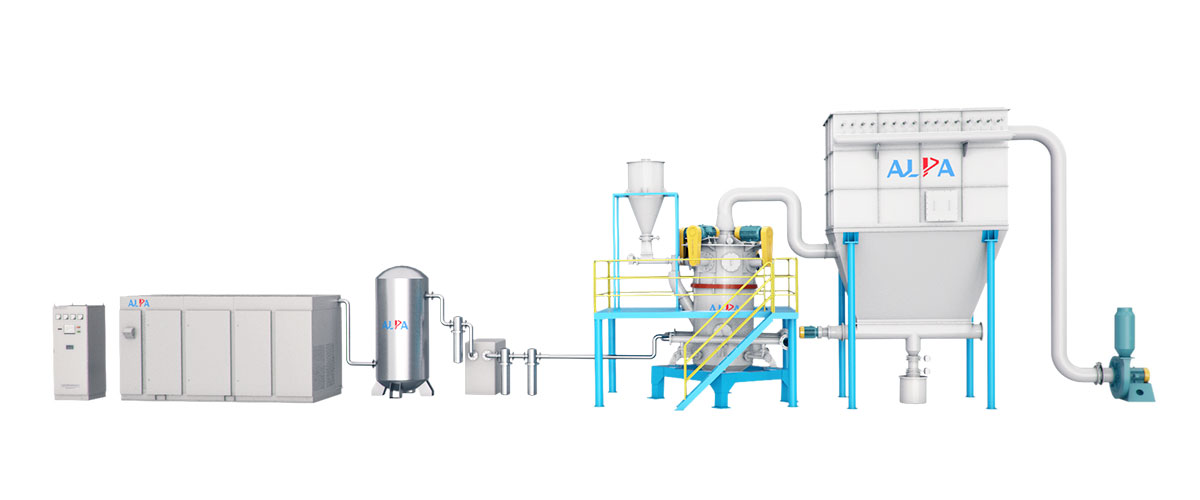
The specific operation mode of the jet mill is that compressed air is filtered and dried, and then sprayed into the grinding chamber at a high speed through the Laval nozzle. At the intersection of multiple high-pressure airflows, the materials are repeatedly collided, rubbed, and sheared to be crushed. The crushed materials Under the action of the fan suction force, it moves with the upward airflow to the classification area. Under the action of the strong centrifugal force generated by the high-speed rotating classification turbine, the coarse and fine materials are separated. Coarse particles descend to the crushing zone to continue crushing.
In addition to the fine particle size of the product, the jet mill products also have the characteristics of narrow particle size distribution, smooth particle surface, complete shape, high purity, high activity, and good dispersibility. Therefore, the jet mill, as an advanced ultrafine grinding equipment, is widely used in the ultrafine grinding of non-metallic minerals and chemical raw materials.
The jet mill is suitable for dry pulverization of various materials with Mohs hardness below 9 and is especially suitable for the pulverization of materials with high hardness, high purity and high added value.
Air classifier technology is becoming more and more important in the powder processing industry
The raw material of the air classifier is not only the basis for the preparation of structural materials, it is also a material with special functions, such as fine ceramics, electronic components, biological engineering treatment, new copy materials, high-quality refractory materials, and materials related to fine chemicals. Required by the field. With the more and more widespread application of air classifiers in modern industry, the status of air classifier classification technology in powder processing is becoming more and more important.
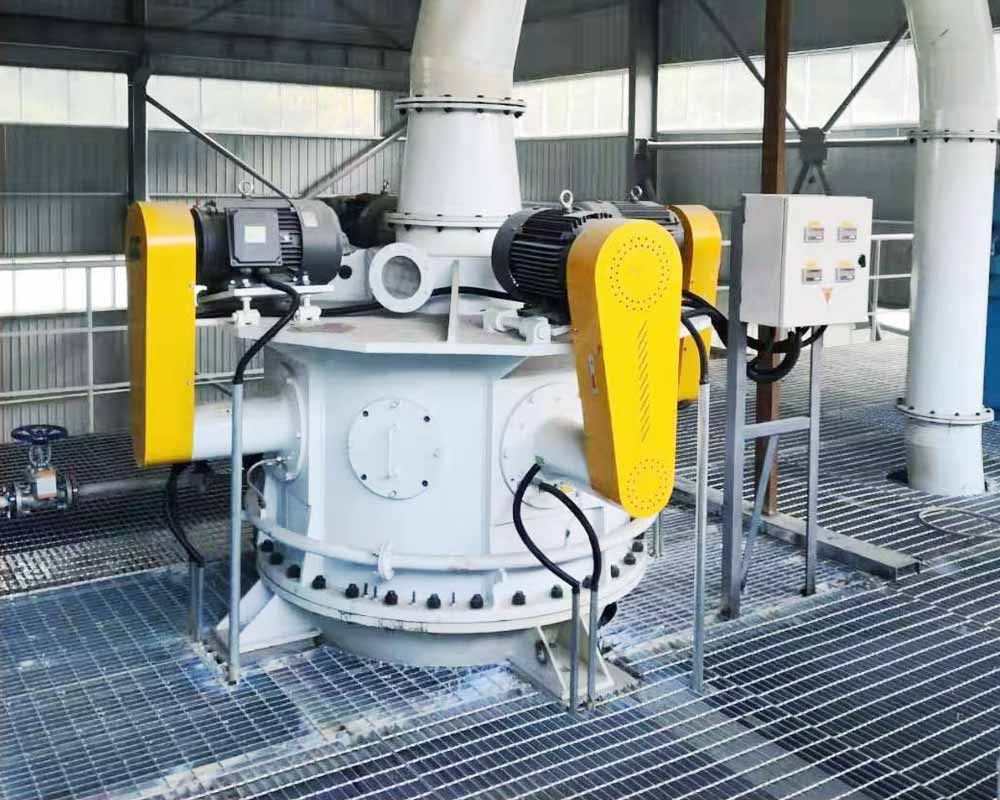
Main research trends of super subdivision
(1) Research and develop new powerful dispersion devices. At present, physical methods and chemical methods have been applied. In the chemical method, it is commonly used to add a dispersing aid to the material before classification in the previous pulverization process, but this method will increase the production cost, and the dispersant may pollute the material, so it is only used in special circumstances. Commonly used physical methods are mechanical or high-speed compressed air dispersion devices, of which high-speed compressed air is the most used. In addition, the chemical method of surface modification to disperse particles is another important way for ultrafine dispersion.
(2) Research on hierarchical flow field. Analyze the flow characteristics of the classification flow field of the turbo-type air classifier and the movement of the classification particles (mainly the movement characteristics of the gas-solid two-phase flow), clarify the influencing factors of the classification flow field, design a reasonable structure form, and reduce local vortices The generation of the grading flow field makes the flow state of the graded flow field as uniform as possible.
(3) The design of the grading force field and the exploration of new grading principles. Through the study of particle surface characteristics, interface states, and the behavior differences of particles in different media and different force fields, new principles, methods and approaches are found, stable and adjustable force fields are designed, and a new and more refined superfine level is developed. machine.
(4) Research on performance parameters and system operating parameters. Through the study of the characteristic parameters of the classifier and the analysis of the operating parameters of the classification system (or crushing-classification system), the classification equipment of reasonable specifications is designed, and the structural parameters and system operating parameters are optimized to make the classification equipment in an ideal working state, that is, high efficiency. , Energy saving and low consumption.
(5) Research on corresponding measures for other problems in the super-subdivision process. For example, in view of the explosion hazard of ultra-fine powder, research on inert gas as a grading medium is carried out; for the tensile test of ultra-fine powder, the development and research of testing devices with good dispersion performance and standard operation can be carried out.
Jet mill has become the first choice for the preparation of cathode materials
Many kinds of equipment can be used to crush the positive electrode material, such as: grinder, pin sand mill, jet mill, etc. Compared with other crushing equipment, the average particle size of the material processed by the jet mill is fine, the particle size distribution is narrower, the particle surface is smooth, the particle shape is regular, the purity is high, the activity is high, and the dispersion is good, which fully meets the preparation requirements of electrode materials. Therefore, jet mills are widely used.
At present, the preparation of cathode materials using jet mills has become the industry's first choice. Jet mill is a kind of equipment that uses high-speed airflow to achieve ultra-fine grinding of dry materials. It consists of a crushing nozzle, a grading rotor, a screw feeder and so on. The material enters the crushing chamber through the screw feeder, and the compressed air is jetted into the crushing chamber at a high speed through a specially configured supersonic nozzle. The material is accelerated in the supersonic jet and repeatedly impacts and collides at the intersection of the nozzles to achieve crushing. The pulverized material enters the classification chamber with the ascending airflow. Due to the high-speed rotation of the grading rotor, the particles are subjected to the centrifugal force generated by the grading rotor and the centripetal force generated by the viscous action of the airflow. When the centrifugal force is greater than the centripetal force, the coarse particles above the grading diameter return to be crushed. The chamber continues to be impacted and crushed, and the fine particles below the classification diameter enter the cyclone separator and collector with the air flow for collection, and the gas is discharged by the induced draft fan.
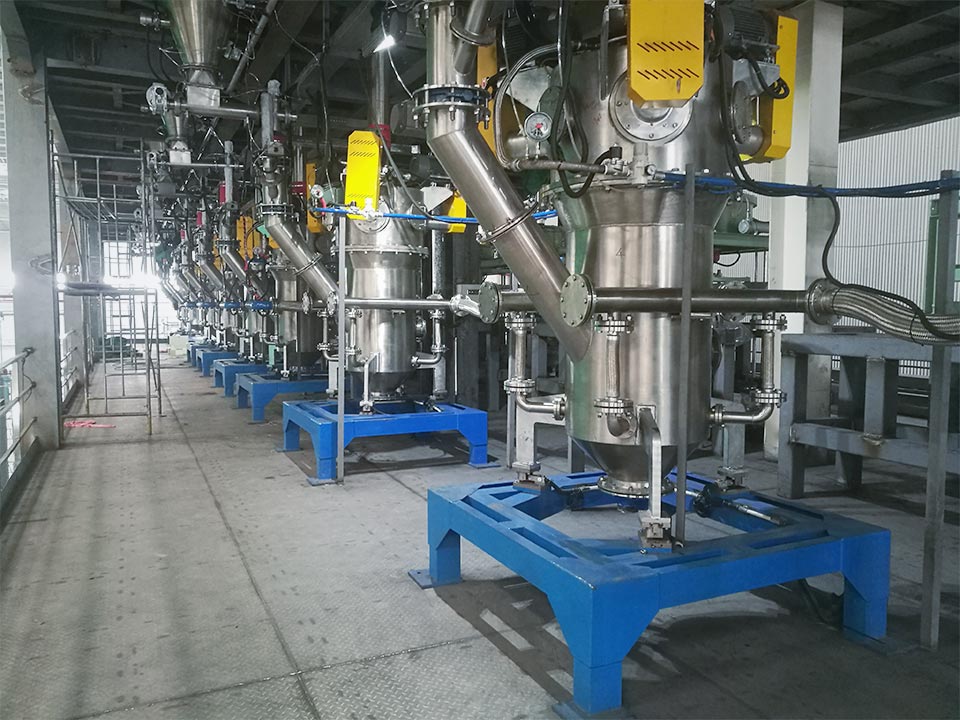
There are many advantages of using a jet mill to prepare cathode materials, which can be summarized as follows:
1. The jet mill has the ability to shape, the finished particles have excellent morphology, and can obtain spherical (potato-like) particles.
2. Narrow particle size distribution and high tap density of the finished product.
3. The over-crushing is low, and the finished product rate can reach 75%-95% or more.
4. The inside of the equipment can be lined with wear-resistant materials, and the finished product has high purity and low equipment wear.
5. The air flow classifier adopts frequency conversion adjustment, which can be adjusted arbitrarily between 0.5μm and 100μm.
6. The equipment runs stably, and there is no difference or change when it is turned on continuously for a long time.
7. Fully enclosed negative pressure operation, automatic control, low noise and no dust pollution.
The jet mill for positive electrode material uses precision ceramics and polyurethane lining, which can 100% prevent metal pollution caused by the crushing process of materials and ensure the purity of crushed products. It is especially suitable for electronic materials that require extremely high iron content, such as lithium cobaltate, lithium manganate, lithium iron phosphate, lithium iron phosphate, ternary materials, cobalt tetroxide, lithium carbonate, lithium nickel cobaltate and other battery cathode materials.
What are the factors related to the degree of pulverization of the jet mill?
Air jet mill is a kind of fine granularity among dry milling equipment, so it is favored by many industries. So to what extent can the jet mill be crushed? Generally speaking, the crushing range of the jet mill is between 1-74 microns. But it does not mean that it can be as thin as 1 micron, but is affected by many factors. Let's take a look below.
The jet mill uses the kinetic energy of high-speed airflow to make particles collide and rub against each other to crush. It has the characteristics of continuous production process, large production capacity and high degree of automation. It can be used in a variety of fine processing industries, such as electronic materials, chemicals, mining, metal powder, etc.
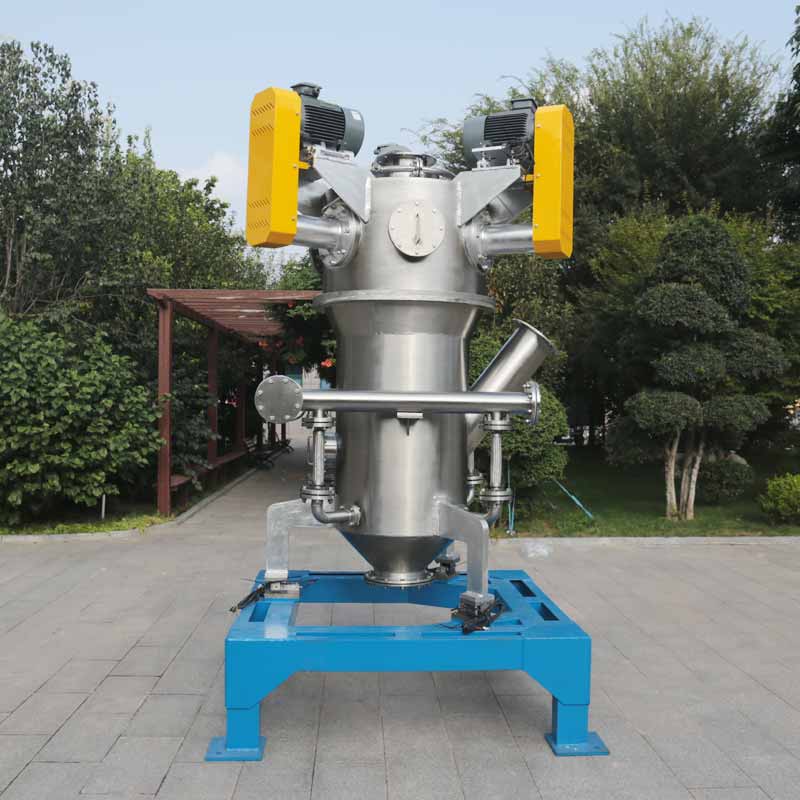
To what extent can the jet mill crush? It is related to the following factors:
1. For the initial fineness of raw materials, the jet mill generally requires the feed to be below 50 mesh.
2. It is related to the physical properties of the material, the fluidity of the material and the uniformity of the particles are related. Some materials have poor fluidity, many impurities, and high solvent content. There may be material blocking during the production process. At this time, special equipment is needed to do this. Not all materials can be pulverized with standard equipment to achieve pulverization fineness. .
3. It is related to the crushing pressure in the crushing process. The feed pressure of some equipment is greater than the crushing pressure, and the crushing pressure of some equipment is greater than the feed pressure. Specific materials need to be specifically designed.
4. It is related to the feeding speed. Not all materials have good fluidity. Whether it is screw feeding or vibrating feeding, the feeding process is a very important factor. Some very fine materials are difficult to feed. , At this time, it is necessary to use a dedicated personalized configuration to achieve the feeding effect.
5. There is also a relationship with the degree of optimization of the jet mill. There are many manufacturers of jet mills, but the fineness of the same material made by different manufacturers is different, even if it is made by different models of equipment from the same manufacturer. The fineness is also different, but according to experience, the effect of a larger crusher is better than a smaller one.
6. It is related to the operation method of the operator's proficiency. Some equipment requires a small and then large pressure operation to start up, and some are directly operated in one step.
It can be seen from the above that there are many factors that affect the limit particle size of the jet mill, the most important of which is the physical properties of the raw material. The drier and brittler the raw material, the finer the limit particle size that can be reached. For example, raw materials such as carbon powder and graphite have better brittleness. If you use a jet mill, you can easily obtain micron or even sub-micron fine powder.
Air classifier is a favorable equipment to control product particle size
The ultrafine air classifier can be operated in a sterile state. The average particle size of the material after the air classifier is fine, the particle size distribution is narrow, the particle shape is smooth, and it has the characteristics of high purity, high activity, and good dispersion. In addition, no heat is generated during the pulverization process, which is suitable for pulverizing low melting point and heat-sensitive substances. Therefore, the ultrafine airflow crusher is very suitable for the preparation of ultrafine drugs. According to statistics, about 25% of the international ultrafine airflow classifiers are used for Pharmaceutical Industry.
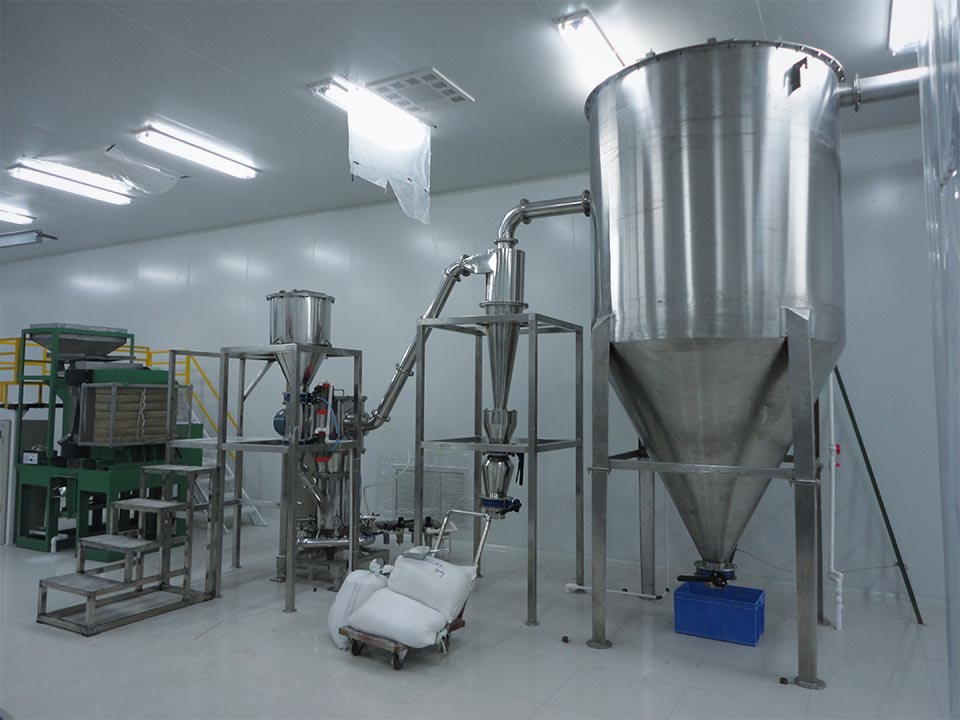
The control of the product particle size by the air classifier mainly depends on the raw material particle size, crushing pressure, feed pressure and feed speed. The logical relationship between the air classifier and these parameters is: the smaller the size of the raw material, the higher the crushing efficiency; the larger the size of the raw material, the lower the crushing efficiency. When the crushing pressure and the feed pressure are constant, reducing the feed speed will make the product finer and thicker. In the case of a certain feed rate, the particle size of the product will be finer, the crushing pressure will be reduced, and the product will become thicker. Therefore, the particle size control depends on the adjustment of the parameters in the ultrafine air classifier process to achieve different grinding fineness. Before smashing, it is necessary to determine the relationship between the feed speed and the pressure and then determine the appropriate smashing parameters to meet the customer's particle size requirements. The particle size of the product needs to be checked by a particle size detector to check the fineness and distribution range. In addition, if the measurement with the electron microscope can be more accurate, of course, it can also be compared with the internationally famous particle size detector.
The air classifier is a relatively precise machine. In the process of daily use and maintenance, some details still need the attention of the operator. In order to improve the classification efficiency of the ultra-fine air classifier, it is necessary to check whether the raw materials meet the requirements before production. Mix foreign matter into the raw material. During the production process, a certain amount of material must be kept in the grinding cavity of the air classifier. Under the condition of constant pulverizing gas flow, there are more materials in the grinding chamber, the current of the classifier is larger, and the materials in the grinding chamber are less, and the current of the classifier is smaller. In addition, the feeding speed must be uniform and stable, not too fast or too slow. If the feeding speed is too fast, the equipment will be overloaded.
The equipment should be maintained regularly, and the air supply pressure should be checked frequently to meet the pressure required for crushing, as well as the classification motor of the airflow classifier. After the equipment runs for 3000 hours, or for long-term shutdown and long-term storage and reuse, please clean the nozzles and grinding chambers. The materials on the inner wall should be cleaned up in time to prevent the classification effect of the air classifier from being affected.
Ultrafine jet mill provides a new way for medical powder
Traditional pulverizers are also very high in particle size and powder extraction rate, and have certain limitations in the powder collection rate and the preservation of effective ingredients, etc., and they need to be adjusted accordingly when used in various industries. The ultra-fine jet mill technology is better when pulverizing, providing a new outlet for ultra-fine Chinese medicine powder.
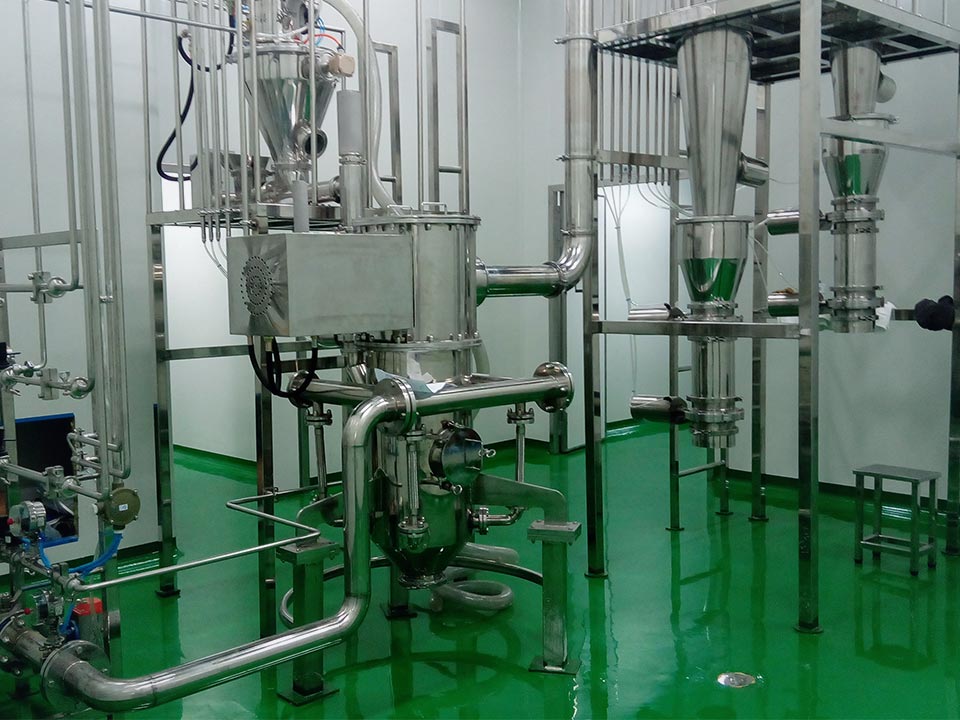
The working principle of the ultra-fine jet mill is to pass purified and dried compressed air through a special nozzle of a certain shape to form an airflow at a speed of 3,600 kilometers per hour. With its huge kinetic energy, the animal materials collide with each other in the closed pulverizing cavity, making Mohs Materials with a hardness of 1-10 are crushed into superfine powder. The size and output of the required particles can be effectively controlled by adjusting the working parameters of the crushing classifier.
The features of ultra-fine jet mill products are:
- The equipment only needs compressed air to run, and does not require a motor for classification. The equipment itself has an automatic gaseous classification device.
- Low energy consumption, jet pulverization itself is a pulverizing process with higher energy consumption. Our equipment has been optimized so that the pulverizing airflow is greater than the feed airflow without back blowing, thus ensuring lower energy consumption.
- The whole system is made of stainless steel, and the internal mirror surface is 0.2 micron polished, which reduces adhesion and loss.
- The cyclone collection system can effectively reduce the loss of materials and avoid expensive production losses.
- Using twin-screw feeding, it can operate continuously and stably effectively, ensuring stable particle size distribution.
- The equipment is easy to clean and install, and easy to disassemble and assemble.
- The equipment is equipped with casters, which can be easily moved to the cleaning workshop to clean the equipment.
With the continuous advancement of ultrafine jet pulverization technology, the pharmaceutical process is also constantly improving. The jet mill plays a relatively large role in the pharmaceutical crushing process, and has made certain breakthroughs in improving the quality of pharmaceuticals. Improving the efficiency, fineness of pulverization and uniform particle size distribution of the ultrafine jet pulverizer is the direction of enterprise research and development.
Applicable scenarios of laboratory jet mill
The laboratory jet mill is suitable for dry, heat-sensitive materials. The equipment does not heat up during operation, has a simple structure, is easy to use, and has no moving parts. When the chemical raw materials and pharmaceutical materials are stable, the materials can be crushed to the limit of 1-3 microns. After crushing, the materials are pollution-free. The optimized compact appearance is suitable for laboratories with high site requirements. The laboratory jet mill is used in small batch production and experiments, and is suitable for ultrafine pulverization and depolymerization of various dry and brittle raw materials, crystals, etc.
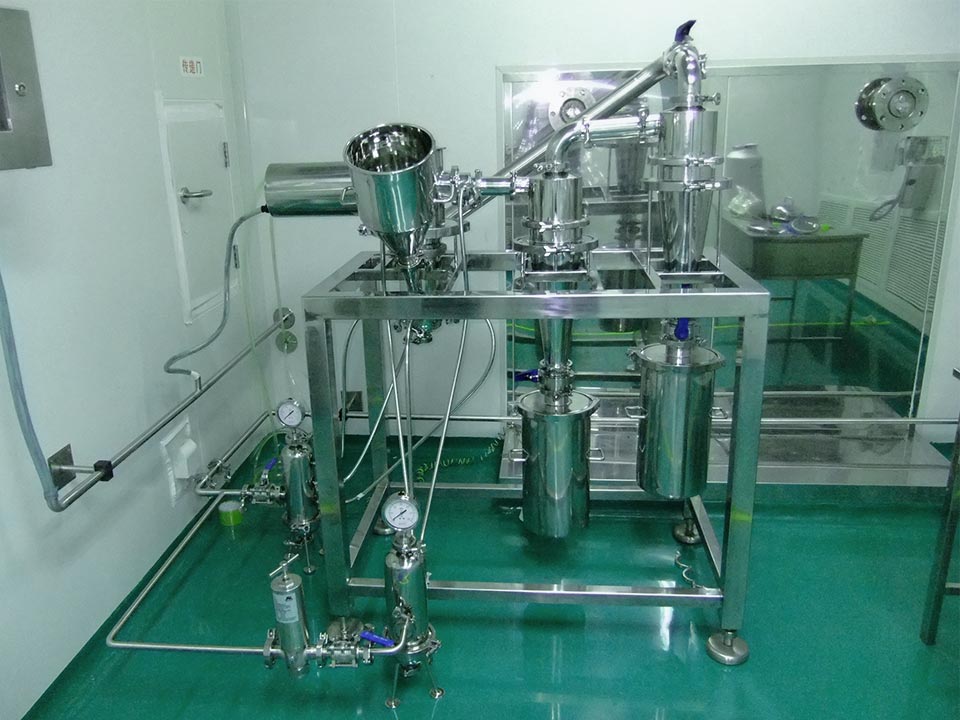
The material of the laboratory jet mill is crushed in a crushing chamber made of high-purity and high-hard materials. Only clean compressed air is in contact with the material, without any other impurities, and no mechanical friction, which greatly guarantees the purity of the product. . The laboratory jet mill is always pulverized at a temperature below normal temperature. Generally, it will not change the chemical properties of materials under room temperature conditions, so it is especially suitable for heat-sensitive raw materials.
The entire system of the laboratory jet mill is sealed and crushed, with less dust, low noise, and the production process is clean and environmentally friendly. The pulverization process of the laboratory jet mill is extremely short, which can be completed in an instant without repeated pulverization, and the efficiency is much higher than other milling equipment. Simple operation, easy disassembly and assembly, and easy cleaning.
The pulverization effect can be achieved by using a laboratory jet mill, all of which require a compressor to provide a compressed air source, but there is a difference between the pulverization process and the process of controlling the particle size.
When choosing a laboratory jet mill, you must understand whether the material you want to process is dangerous. If there is a risk of dust burning or explosion, you have to consider using nitrogen as the pulverizing medium. It must not be used for cost and safety protection. Because the jet mill is ultra-fine pulverization, the finer the raw material particles are processed, the larger the specific surface area. The risk factor is also greater. The other is to consider the safety protection of the equipment itself, whether anti-static filter bags are used, and whether there are measures such as system pressure monitoring.
The laboratory jet mill is an ultrafine pulverizing equipment, not a nanometer pulverizing equipment. This physical method is difficult to reach the nanometer level. The laboratory jet mill is mainly used for a small number of samples, easy to clean is a more important function.
What are the characteristics of jet mill used for silica matting powder
Silica can be used in all coatings. In the processing of silica matting powder, pulverization and classification are indispensable. At this time, a fluidized bed jet mill is needed. The equipment uses high-speed airflow to carry the animal material, so that the particles of the raw material are friction and shear between the particles, and the particles and the inner wall of the equipment collide with each other, so that the raw materials are subjected to double pulverization, and the pulverization efficiency is improved. Therefore, the fluidized bed jet mill is almost instantaneous. The raw materials can be crushed to ultrafine powder state.
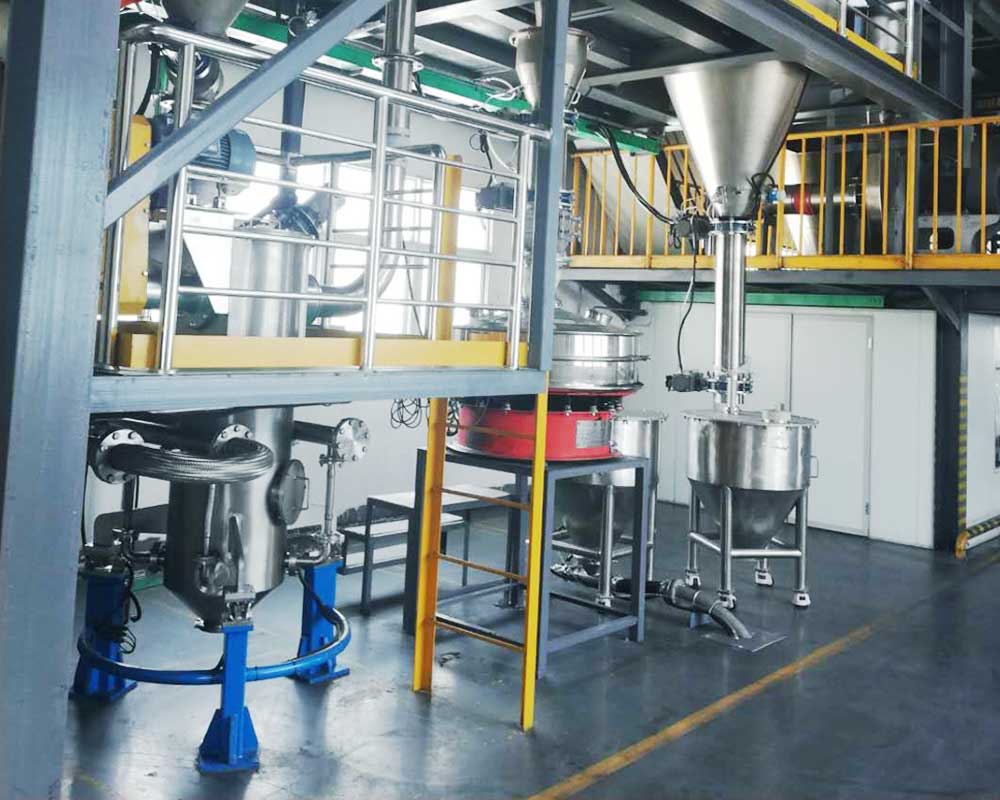
The fluidized bed jet mill for silica matting powder has the following characteristics:
The principle and characteristics of the lower crushing area are the same as those of the disc-type supersonic jet mill, so that the powder added to the mill is easily hit by the air flow, and has a higher crushing probability than the fluidized bed collision type model.
The upper classification principle adopts fluidized bed type horizontal turbine forced classification, the cutting point is accurate, the efficiency is high, and any raw material of different hardness can be controlled.
In the crushing process, due to the forced classification of the upper turbine, the coarse material settles on the bottom of the crusher. The powder concentration in the crushing area is much higher than that of the disc jet mill, so this model is more pulverized than the disc jet mill higher efficiency.
The materials of the crushing parts are all made of corundum ceramic materials, including the high-speed classifying impellers are all made of corundum ceramic materials. Ensure that the pulverized material maintains high purity, no contamination by impurities, and the whiteness of the finished product is not affected.
The raw materials can be selected according to the customer's process requirements and performance requirements such as raw material whiteness, transparency, particle hardness, pore volume oil absorption value, etc. The crushing model can process powder products that meet the required particle size.
When processing silica matting powder, its product fineness can be d100<18μm. When it smashes the crushed object, it can adjust the median diameter of the finished product while ensuring the upper limit of the control particle size. The particle size distribution (median diameter) of the required powder product can be controlled manually.

